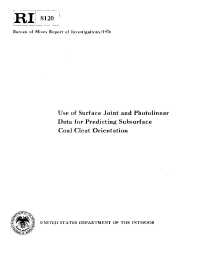Mining Publication: Use of Surface Joint and Photolinear Data for Predicting Subsurface Coal Cleat Orientation
Original creation date: January 1976
Coalbeds exhibit a directional permeability, with the maximum permeability oriented parallel to the face cleat. Thus, the most efficient pattern of vertical degasification holes for a coalbed is dependent upon cleat orientation. Surface joints, infrared photolinears, and ronchi grating photolinears were investigated as potential estimators of subsurface cleat orientation. Cleat orientations were measured in 18 mines in the Pittsburgh coalbed in southwestern Pennsylvania and northern West Virginia to be used as a standard against which prediction techniques would be evaluated. Two cleat systems with a strong geographic segregation were measured in the study area: n 67 deg. W - n 28 deg. E (95 deg. Separation) for the north, and n 76 deg. W - n 17 deg. E (93 deg. Separation) for the south. Directional data obtained from the three techniques investigated yielded satisfactory regional predictions of cleat orientation. Analysis of surface joints was the only technique considered sufficiently reliable on a local basis. Prediction of cleat orientation is based on the pairing of the principal directional sets into all reasonable combinations of fundamental systems. The system or systems composed of the most dominant sets nearest to 90 deg. Separation are likely to be a reliable prediction of cleat orientation. The most dominant set of the system selected is likely to be the face cleat.
Authors: WP Diamond, CM McCulloch, BM Bench
Report of Investigations - January 1976
NIOSHTIC2 Number: 10000581
Pittsburgh, PA: U.S. Department of the Interior, Bureau of Mines, RI 8120, 1976 Jan; :1-13
See Also
- Analysis of Mine Fires for All U.S. Underground and Surface Coal Mining Categories: 1990-1999
- Development of Coal Mine Face Ventilation Systems During the 20th Century
- Equivalency of a Personal Dust Monitor to the Current United States Coal Mine Respirable Dust Sampler
- Guidelines for the Control and Monitoring of Methane Gas on Continuous Mining Operations
- Methods for Controlling Explosion Risk at Coal Mine Working Faces
- Modeling and Data Analysis of 50 to 5000 kHz Radio Wave Propagation in Coal Mines
- Multiple-Seam Mining in the United States: Design Based on Case Histories
- Predicting Methane Emissions from Longer Longwall Faces by Analysis of Emission Contributors
- Prediction of Longwall Methane Emissions and the Associated Consequences of Increasing Longwall Face Lengths: A Case Study in the Pittsburgh Coalbed
- Rock Mass Behavior and Support Response in a Longwall Panel Pre-Driven Recovery Room
- Content source: National Institute for Occupational Safety and Health, Mining Program


 ShareCompartir
ShareCompartir
